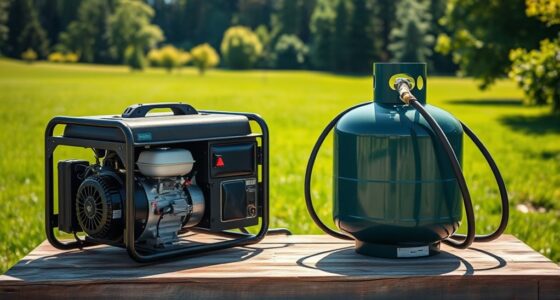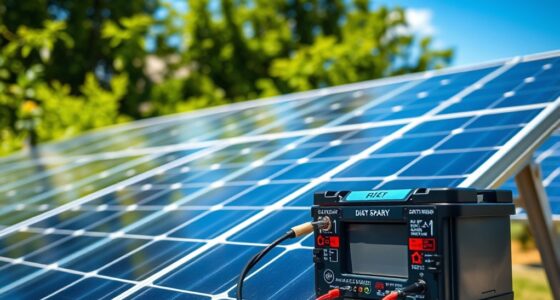A transfer switch connects your home to an emergency generator safely during power outages by isolating your wiring from the utility grid, preventing back-feed hazards. It guarantees your generator works with your home’s electrical system without risking electrical shock or damage. There are manual and automatic types to suit different needs. Proper installation and regular maintenance are key for safety and reliability. Keep exploring to learn how to choose and care for your transfer switch effectively.
Key Takeaways
- A transfer switch safely isolates your home from the utility grid during generator use, preventing back-feed hazards.
- It automatically or manually switches power sources, ensuring reliable and safe operation during outages.
- Proper installation following electrical codes and using correct wiring are essential for safety and compliance.
- Regular maintenance and inspections help prevent malfunctions and extend the lifespan of the transfer switch.
- Hiring licensed electricians ensures correct setup and reduces risks associated with electrical hazards.
What Is a Transfer Switch and How Does It Work?

A transfer switch is a device that safely connects your home to an alternative power source, such as a generator, during an outage. It guarantees your generator is compatible with your home’s electrical system by properly managing the flow of power. When installed, the switch isolates your home’s electrical wiring from the utility grid, preventing back-feed that could harm utility workers or damage equipment. It automatically or manually switches power sources, allowing you to run essential appliances without risking unsafe wiring conditions. Proper electrical wiring is essential for a transfer switch to function correctly, guaranteeing safe operation and reliable power transfer. By integrating the switch with your electrical system, you get a seamless and safe way to power your home during outages. Additionally, understanding proper installation and maintenance is crucial to ensure the safety and longevity of your transfer switch.
Why Is a Transfer Switch Important for Home Safety?
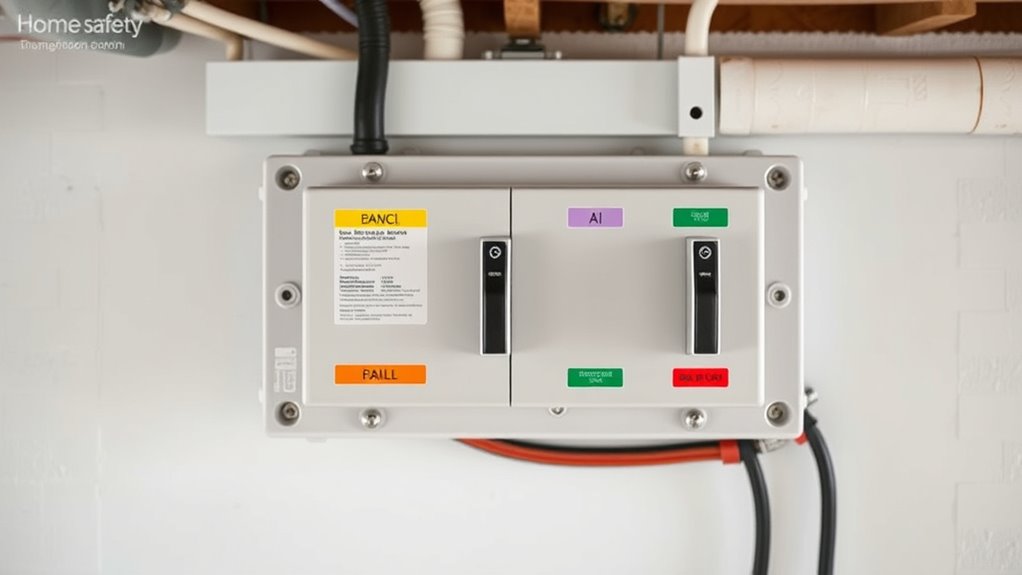
Using a transfer switch enhances your home’s safety during power outages by preventing dangerous electrical hazards. It guarantees your generator is compatible with your home’s electrical system, reducing the risk of backfeeding, which can harm utility workers or damage appliances. Proper power management is vital, as a transfer switch directs electricity only to the circuits you choose, avoiding overloads or unintentional energizing of unused outlets. Without a transfer switch, manually connecting a generator is risky and can lead to electrical fires or electrocution. It also helps you manage your power supply efficiently, guaranteeing your essential appliances operate safely and reliably. Additionally, code compliance with electrical standards is crucial to ensure your setup is safe and legally compliant. Overall, a transfer switch is an essential safety device that provides peace of mind during outages by protecting both your household and utility workers.
Types of Transfer Switches Suitable for Residential Use
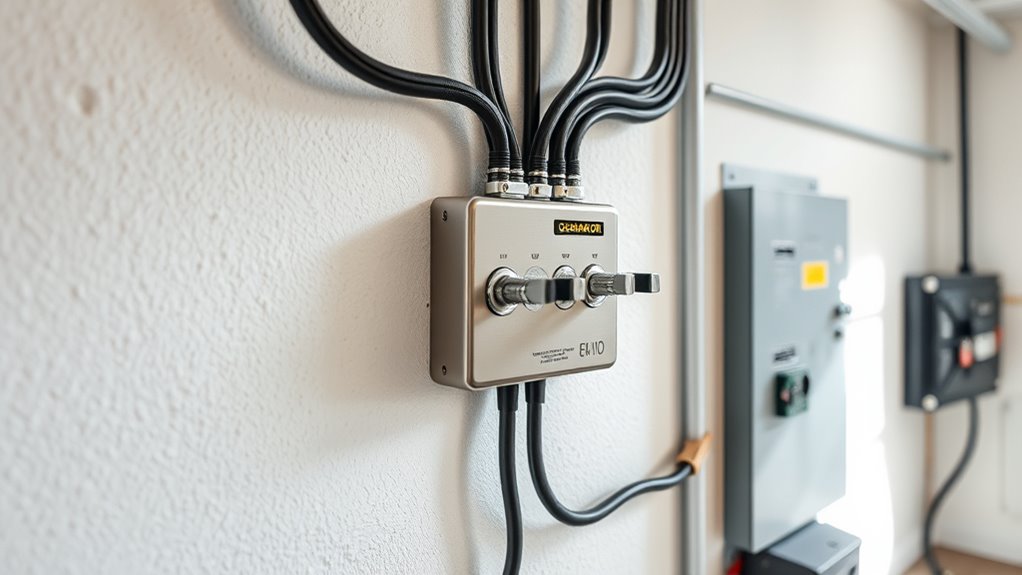
When selecting a transfer switch for your home, it’s important to understand the main types designed specifically for residential use. The two most common are manual and automatic transfer switches. Manual switches require you to activate them during an outage, while automatic switches detect power loss and switch seamlessly. Consider generator compatibility: some switches work better with portable generators, others with standby models. Cost comparison varies: manual switches are generally more affordable upfront, but automatic switches provide convenience and safety. Here’s a quick comparison:
| Feature | Manual Transfer Switch | Automatic Transfer Switch |
|---|---|---|
| Generator Compatibility | Portable, standby | Standby, portable |
| Cost | Lower | Higher |
| Convenience | Requires manual operation | Seamless, automatic |
Choosing the right switch depends on your generator type, budget, and safety preferences. Additionally, understanding the transfer switch function can help ensure proper installation and operation.
Installation Considerations and Safety Tips
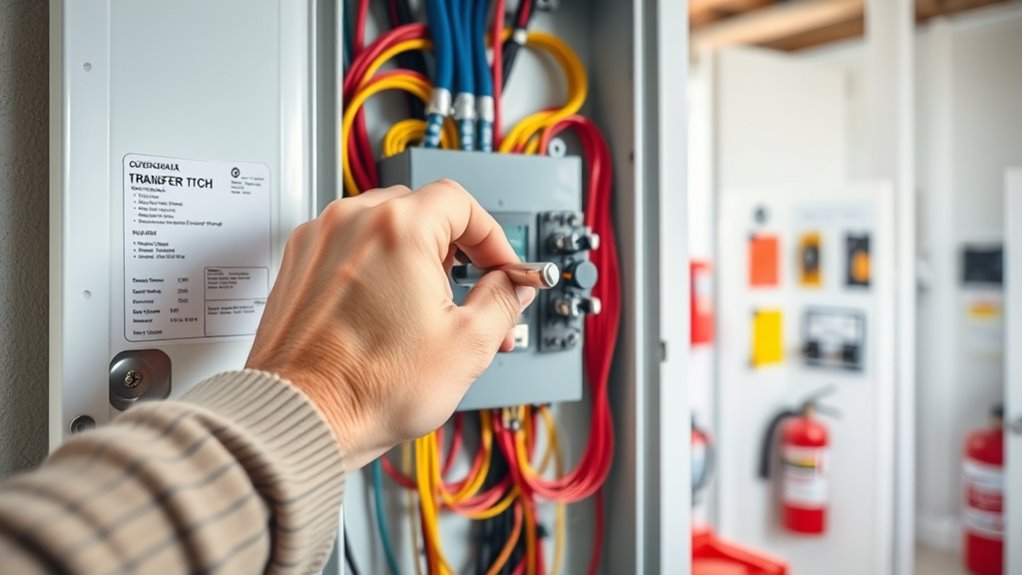
Proper installation of a transfer switch is essential for safety and reliable power transfer. To guarantee generator safety, follow all local electrical codes and manufacturer instructions carefully. Start by turning off the main power before connecting the transfer switch, preventing backfeeding and electrical hazards. Make sure the switch is properly grounded and installed in a dry, accessible location. Use the correct gauge wiring for your system to avoid overheating. If you’re not experienced, hire a licensed electrician to handle the installation. This helps you meet electrical codes and ensures a safe, compliant setup. Always double-check connections before powering up the system. Remember, improper installation can cause dangerous electrical issues and compromise your safety, so prioritize following all safety tips and regulations. Additionally, understanding transfer switch functionality can help you operate your system more effectively and safely.
Maintenance and Troubleshooting of Transfer Switches

Regular maintenance and prompt troubleshooting are key to ensuring your transfer switch functions reliably when you need it most. Regular generator maintenance, including inspecting connections and cleaning components, helps prevent unexpected failures. Follow troubleshooting procedures if your transfer switch isn’t activating properly, such as checking circuit breakers, testing the control wiring, and verifying power supply. Keep an eye out for corrosion, loose connections, or worn parts that could impair operation. If you notice any irregularities, consult your manufacturer’s guidelines or contact a professional for assistance. Performing routine checks and addressing issues early can extend the lifespan of your transfer switch and ensure it works seamlessly during an outage. Staying proactive with maintenance and troubleshooting guarantees your safety and peace of mind. Incorporating industry trends into your knowledge can help you stay updated on the latest safety and technology improvements.
Frequently Asked Questions
Can I Install a Transfer Switch Myself or Should I Hire a Professional?
You shouldn’t attempt a DIY installation of a transfer switch. It’s best to hire a professional electrician because this task involves complex wiring and safety risks. A licensed electrician ensures the transfer switch is installed correctly and complies with local codes. Doing it yourself could cause electrical hazards or damage your system, so investing in a professional guarantees safety and peace of mind during power outages.
How Much Does a Residential Transfer Switch Typically Cost?
A residential transfer switch typically costs between $300 and $1,200, depending on the size and features. Your cost estimation varies based on the switch’s capacity and brand, along with installation expenses if you hire a professional. Keep in mind that investing in a quality transfer switch guarantees safety and reliability during power outages. Always compare prices and consult with a professional to choose the best option for your home.
Are There Any Local Regulations or Permits Required for Installation?
You should check your local regulations and permit requirements before installing a transfer switch. Many areas require permits to ensure safety and code compliance, and failure to obtain them can lead to fines or issues during home inspections. Contact your local building department or city hall to find out specific rules. Securing the necessary permits helps you stay legal and guarantees the installation is done correctly and safely.
How Does a Transfer Switch Affect My Home Insurance Coverage?
You might wonder if installing a transfer switch affects your home insurance. The answer is, it could influence your coverage considerations. Some insurers view transfer switches as an upgrade that enhances safety and reliability, potentially lowering premiums. However, others may see it as an added risk, prompting them to adjust your policy or require additional documentation. Always check with your insurer first—knowing the insurance implications guarantees you’re fully protected and prepared.
What Are the Signs That My Transfer Switch Needs Replacement?
You’ll know your transfer switch needs replacing if you notice warning signs like frequent malfunctions, sparks, or a burning smell. If it doesn’t switch properly during a power outage or makes unusual noises, these are signs of transfer switch malfunctions. Don’t ignore these warning signs; timely replacement guarantees safety and reliable operation. Regular inspection helps catch issues early, preventing potential electrical hazards and ensuring your backup power system remains ready when you need it.
Conclusion
A transfer switch is like a reliable guardian, seamlessly switching your power source and keeping your home safe. By understanding its functions, importance, and maintenance needs, you ensure your home stays protected, even during outages. Think of it as the steady captain steering your ship through stormy waters—trust it to keep your family safe. Investing in a good transfer switch is a smart move, giving you peace of mind whenever the lights go out.


